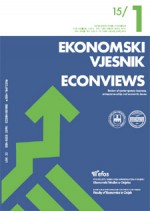THE RELATIONSHIP BETWEEN TANGIBLE ASSETS AND CAPITAL STRUCTURE OF SMALL AND MEDIUM-SIZED COMPANIES IN CROATIA
THE RELATIONSHIP BETWEEN TANGIBLE ASSETS AND CAPITAL STRUCTURE OF SMALL AND MEDIUM-SIZED COMPANIES IN CROATIA
Author(s): Martina HarcSubject(s): National Economy, Business Economy / Management, Micro-Economics
Published by: Sveučilište Josipa Jurja Strossmayera u Osijeku, Ekonomski fakultet u Osijeku
Keywords: Tangible assets; capital structure; leverage; small and medium-sized enterprises;
Summary/Abstract: The asset structure of companies should matter for financing decisions. Small and medium-sized companies in Croatia may use tangible assets as collateral, either providing more access to creditors or as a guarantee in case of bankruptcy. The aim of this paper is to investigate the relationship between tangible assets and the capital structure of Croatian small and medium-sized enterprises. Most previous studies have shown various relationships between tangible assets and leverage. This study has been conducted on a sample of 500 Croatian SMEs for the period between 2005 and 2010. The data used for the empirical analysis were taken from companies’ annual reports. The Pearson Correlation Coefficient is applied in order to examine the relationship between tangible assets and leverage measures. The results of this research indicate that tangible assets are differently correlated with short-term and long-term leverage. The relationship between tangible assets and short-term leverage is negative and statistically significant in all observed years. The relationship between tangible assets and long-term leverage is positive in all observed years and statistically significant. The results show that small and medium-sized companies use their collateral to attract long-term debt, which means that small and medium-sized companies use lower costs and the interest rate of long-term debt in relation to short-term debt. These findings correspond with the maturity matching principle, according to which long-term assets are financed with long-term financing and short-term assets are financed with short-term funds. These results suggest that tangible assets have a positive impact on the long-term debt of Croatian SMEs because tangible assets constitute a positive signal to the financial institutions, which can request the selling of these assets in case of bankruptcy. These findings are consistent with the trade-off theory which predicts a positive relation between leverage and tangibility, but also with the pecking order theory, which is generally interpreted as predicting a negative relation between leverage and tangibility.
- Issue Year: 28/2015
- Issue No: 1
- Page Range: 213-224
- Page Count: 12
- Language: English

